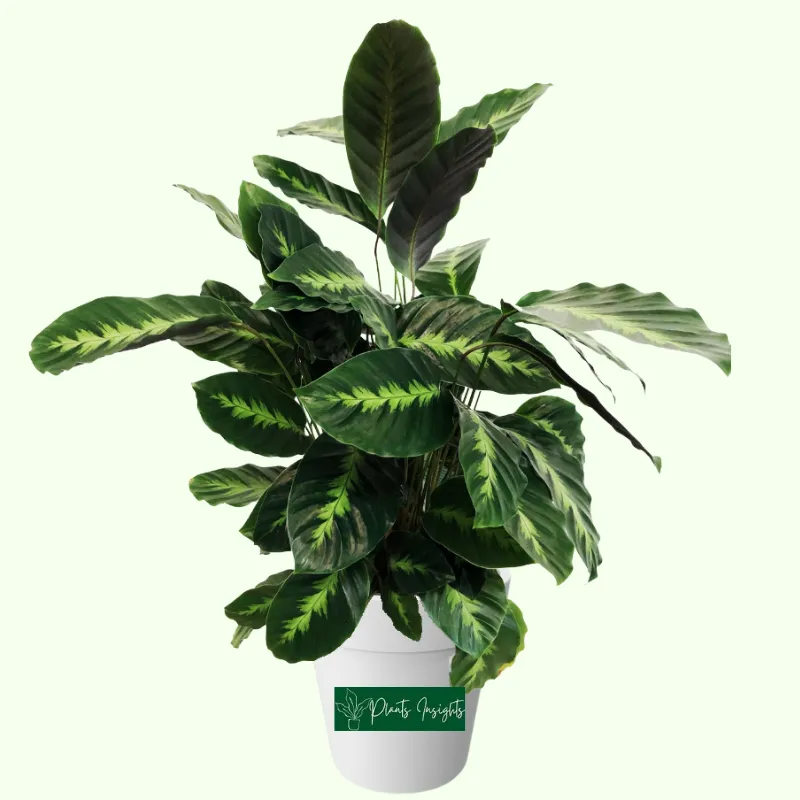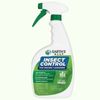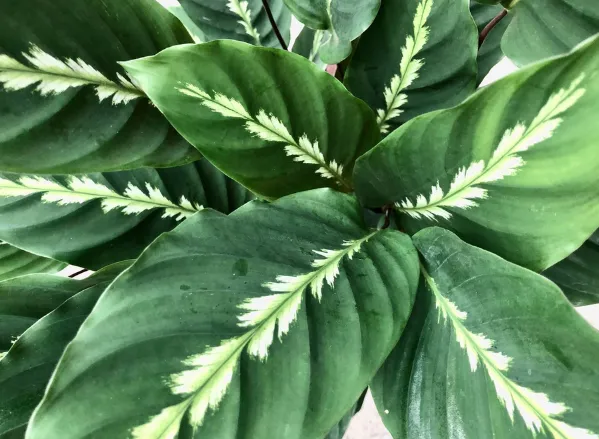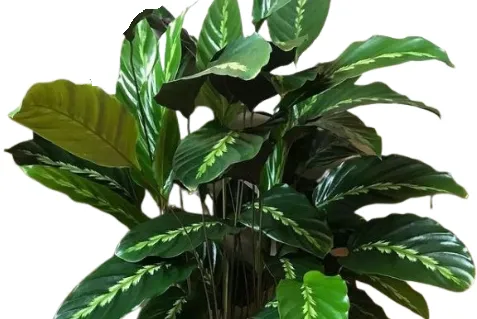Calathea Louisae is an adoring, colorful plant boasting beautiful leaves and a unique color pattern. It perfectly displays the beauty of the Calathea family, known for its exotic foliage with ornate, symmetrical shapes. The plant is one of the less commonly found Calathea and is also known as Calathea Maui Queen. It is native to Brazil and belongs to the family of Marantaceae. The most distinctive feature of Calathea Louisae is the gorgeous dark green foliage, with vivid cream-colored stripes in the middle. The leaves also feature purple insides, which further enhance the beauty of the plant.
Calathea Maui Quen Beauty has the power to revitalize any interior and bring joy into our homes. Calathea Louisae is an ideal present for anyone you love due to its magnificence and zeal. The plant can grow up to three feet in height if proper care is provided.
Popular Family Members: Calathea Medallion, Calathea Zebrina, Calathea Lancifolia, Calathea Rufibarba, Calathea Ornata, Calathea Orbifolia, Calathea Warscewiczii
Essential Products
How to care for Calathea Louisae?
Calathea Louisea originates from the tropical Amazon, and mimicking its native conditions will help plants thrive and flourish. Maui Queen is a plant that needs a medium level of care and let us discuss what we can do for the betterment of the plant.

Bringing Calathea Maui Queen to Home
The Calathea Louisae is a beautiful addition to any home; however, it’s vital that you thoroughly check the health of the new plant before putting them in with other indoor plants. The new Calathea Louisae may have hidden pests or infestations, affecting your other indoor plants.
We recommended that you leave these new arrivals separate for at least two weeks and watch out for signs of infestation to avoid the risk of introducing diseases into your collection. Initially, the leaves of Calathea Louisae may droop as a natural phenomenon of adjusting to the new home.

Calathea Louisae Light Requirements
In nature, Calathea Louisae grows in deep shade under other canopy trees along the forest floor without supplemental light. They love plenty of indirect sunlight and will thrive in your home if you give them the amount of light. Emulating the plant’s natural condition in your home will best serve.
We recommend never to place the Calathea Louisae plant in direct sunlight as it will burn the gorgeous delicate leaves of the plant. Whereas, if the plant is not supplied with required sunlight for a longer duration, it will show discoloration of leaves and fading patterns and stripes.
Preferably place your Calathea plant a few feet away from the sunlight receiving window, where the plant is not exposed to direct sunlight; however, it will be getting bright indirect sunlight. To confirm the plant location concerning sunlight, observe the plant’s shadow. The shadow of your plant should look fuzzy instead of dark shadow.
If you are still not sure about the light, you can use a light intensity meter to confirm the light exposure for the plant. Light intensity is also measured in Foot Candle (FC) units, and Calathea Louisae will thrive best in light intensity of 400 FC.

Humidity and Temperature
If you start noticing the browning of leaves edges, one of the reasons could be the lack of humidity. Plants originating from the rainforests of the Amazon adore humidity, and the same is the case with Calathea Louisae. The plant thrives most in the humidity of 50 – 60 %. Calathea Maui Queen will not flourish if the optimum humidity level is not met.
Please be informed even if you are living in a humid area, your indoor humidity may not be ideal for the plant. Indoor humidity largely depends on the heating or cooling system used. In winter, humidity drops substantially if you use an indoor heating system.
Likewise, air conditioning reduces indoor humidity in summer as all air conditioning systems have built-in dehumidifiers. Therefore, we recommend keeping all considerations in your mind before deciding to adjust your home’s indoor humidity.
There are several ways like the grouping of plants together, the use of transparent polythene over plants, or an occasional shower to provide a more humid environment. Some plant owners excessively mist the plants to provide them with the required humidity. We strongly discourage this approach because if mist water remains on the leaves for long or overnight, it will cause fungal diseases and spotting. The best method to reach optimum humidity level is using a humidifier for your plants.
Calathea Louisae can be grown within the temperature range of 65 -85° F; however, the plant loves warmer temperatures. In its natural habitat, the temperature remains uniform all around the year. Therefore, the plant does not like changes in the temperature of its surroundings and can happily tolerate temperature changes only up to 4° F. This implies that your Calathea Louisae shall be protected from any hot or cold drafts. Hence, place your plant indoors at a location that is not exposed to chill from outdoors or a hot draft from an internal heating system.

How much I should water Calathea Maui Queen?
Like most species of the Marantaceae family, this plant revels in a moist environment. However, if the soil becomes over-saturated with water, it will harm the roots. Calathea Fusion White and Musaica do not want to live in waterlogged soil like other family members. If excess water remains in the soil, it will cause yellowing of leaves and roots rotting. Therefore, take special care when finalizing the watering regime for Calathea Maui Queen.
Always water the plant when the soil has become partially dry, which means that the top one-inch layer of soil should not have moisture before watering the plant again. You can check the soil moisture by using your finger, or a soil moisture meter can be a more accurate option for this check.
During winter, the watering requirement of Calathea Maui Queen reduces as the plant becomes dormant. Therefore, adjust your watering cycle accordingly. Another precaution is to always use water at room temperature for watering Calathea Louisae.
Watering cold water is not advised because this will thermally shock the roots. If your tap water is high in chlorides and fluorides, you should not use tap water because it will kill the microorganisms in the substrate. Tap water also contains salts that accumulate in the potting soil and can cause damage to roots if not removed regularly.
The best recommendation would be to use distilled or rainwater for watering the Calatheas. However, if both options are not a choice for you, use filtered water or keep water in a pot for 24 hrs before watering the plant.

Calathea Lousiea Soil Requirements
Like Calathea Zebrina and White Fusion, this Calathea also favors moist soil with good drainage properties. Dampness in the soil is crucial for the growth and development of Calathea Louisae, whereas drainage capabilities will avoid severe problems like root rot and fungal diseases. Calathea Maui Queen prefers soil with an acidic pH level of 6.5.
We recommend using one-part houseplant potting soil, two parts perlite, and two parts of peat to make a perfect potting soil mixture for Calatheas. However, if you are not into making your soil mix and cannot find a Calathea explicit potting soil in the market, use African Violet potting soil mix as it matches Calathea’s requirement.
If you have fungal-related problems, a small amount of calcium should also be added to the substrate to prevent the roots from rotting.

Cleaning and Maintenance
Calathea Maui Queen does not require regular pruning. If you notice any discolored or sick leave, it is advisable to remove the leave by hand or sheering scissors. This timely pruning of unhealthy leaves will prevent the spread of disease and boost new growth.
Calathea Louisae’s leaves are gorgeous, and they radiate more if kept clean. We recommend occasionally cleaning the leaves with a wet cloth to boost the plant’s aura. Do not use any wax or shine product on the leaves. Calathea Lousiea leaves have tiny pores, which are required for plant breathing. The shine product on the leaves can cause these pores to clog. This can ultimately result in degradation in plants’ health.
Minerals from water and fertilizer can build up soil and cause stunted growth by affecting the roots. Therefore we recommend flushing the soil of your Calathea Louisae after a few months for better plant growth.
Flushing of soil is a simple procedure where you put the plant underwater flow for two to three minutes and let the drainage water take away all the accumulated salts with it. Drain the excess water properly after flushing, and do not rewater the plant until the soil becomes partially dry.

Fertilizer for Varigated Calathea
Your Calathea Louisae plant needs occasional fertilization during the growing season. If you decide that going through with adding nutrients would be helpful toward achieving better growth rates, then feed them during periods when there’s most active development, which is in spring and summer.
Lush Green leaves after Fertilizing
You can use a common nitrogen-based houseplant liquid fertilizer for your Calathea every month during the growing season. We recommend diluting the fertilizer to one-quarter of its strength by adding water. Never over-fertilize the plant as it can cause leaf burn and browning the leaves edges.
Additionally, do not feed the plant in dormant winter as the plant will not consume the fertilizer in the non-growing season, and the result will be the accumulation of minerals in the soil that will adversely affect the roots system.

Repotting Maui Queen Plant
We recommend repotting the Calathea Louisae every year at an early age. Once the plant has reached a mature age of four years, repotting can be done at a frequency of two years.
Repotting is necessary if there are indications of roots outgrowing the pot and you notice a stunted growth or wilting of leaves without any other apparent reason. The best time for repotting is before the spring season.
You can follow the following straightforward steps to repot your Maui Queen plant.

Propagation
Like its other family members, Calathea Louisae can be successfully propagated by the division of roots. The other propagation techniques like through seeds or cuttings haven’t been much successful for Calatheas.
If you have a thriving and flourishing Calathea Louisae with several stems and growing roots, propagate the plant along with the repotting activity.
We have provided a simple guide to propagate your Calathea Maui Queen. Carry out these additional steps while repotting to achieve fruitful propagation.

Is Calathea Louisae pet safe?
Calathea Louisae is completely non-toxic to pets and humans; therefore, it makes the list of great houseplants extremely gorgeous and safe for everyone.
However, despite their non-toxic nature, always take care that small kids or pets do not consume the plant leaves. Consumption of leaves in larger quantities irrespective of toxicity can be harmful to kids and pets.

Common Pests, Problems and Queries
Pests
Calathea Louisae plants prefer humid and moist environments, making them extra vulnerable to pest assaults and fungal illness. The most usual bugs that attack the Maui Queen plant are termites, mealybugs, thrips, and aphids. Please carry out frequent assessments of your plants to identify invasions at the earliest phase.
In case you notice any infestation on the plant, the first line of action would be to remove the pests manually. Additionally, cut away the infected leaves to control the spread of disease. A dilute solution of cleaning alcohol can is also helpful in cleaning. However, test the solution on a single leaf before using it all over. Neem oil application on leave also prevents the development of infestation. If you cannot control the disease with these methods, pesticides can also be applied for remedy.
Leaves Yellowing
Leaves yellowing and dying is a natural phenomenon associated with the plants; however, if you notice excessive yellowing of Calathea Louisae, unnecessary watering can be the most probable root cause of the problem. To fix the plant, reduce the water input to the plant, and let the soil dry. Moreover, only rewater your Calathea Louisae when you notice that the top one-inch soil has become dry.
Please ensure that water drainage holes in the pot are not clogged. If the situation does not improve, you can also plan to change the soil to a more draining type if the situation does not improve.
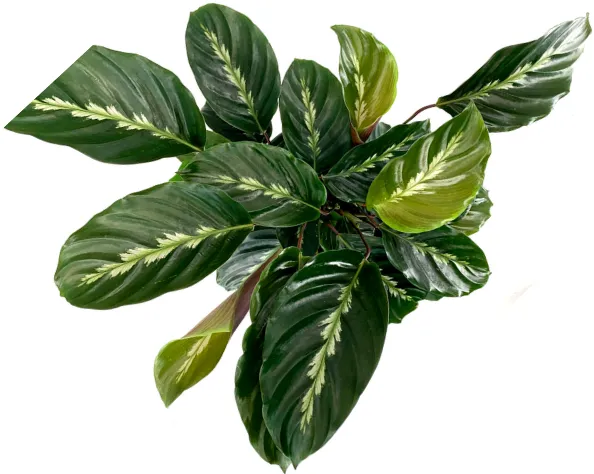
Yellowing of Leaves
Why Calathea Louisae leaves are curling up?
If the Calathea Louisae plant is exposed to higher temperatures, nature has put curling up leaves as a defense mechanism in these plants. As the leaf curls up, the surface area is exposed to heat reduces, and the leaf can preserve moisture for a longer period. If you notice the curling up of the leaves, move your plant to a cooler place or remove the source of extra heat.
Is Calathea Louisae an indoor plant?
Calathea Louisae is a tropical plant that grows under the shade of tall trees in warm and humid conditions. It won’t be easy to maintain such conditions outdoors all around the year. Therefore, Calathea Louisae is more preferred as an indoor plant. It can grow outdoors in the shade; however, outdoor temperature shall remain more than 60F with a humidity greater than 50%.
You can also plan to bring your plant indoors when the weather cools down in autumn.
Is Calathea Louisae rare?
Calathea Louisae is not as commonly found as other family members of the Calathea family. The dark green foliage of the plant is beautiful, and the cream color feather pattern in the middle of the leaf span looks stunning. Other plant family members do not possess these feather patterns, an exclusive feature of Calathea Louisae.

